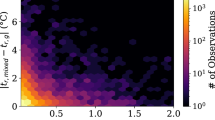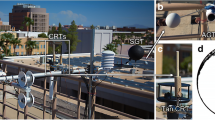Abstract
A mathematical model to estimate outdoor thermal comfort for humans from micrometeorological data has been formulated using the energy balance concept and the simultaneous satisfaction of four criteria for comfort from the literature: (a) a comfortable perspiration rate, (b) a comfortable core body temperature, (c) a comfortable skin temperature, and (d) a near-zero energy budget. A cylindrical modification of the globe thermometer is proposed as a simple monitor of outdoor radiation absorption for a person, and the effect of windspeed on the thermal resistance of clothing is considered. Results show a correlation coefficient of 0.91 between model output and subjective comfort ratings of 59 different situations with a variety of temperatures, insolations and windspeeds.
Similar content being viewed by others
References
BROWN, R. D. (1982): Application of Human Thermal Comfort to Landscape Architecture: A New Approach. Master of Landscape Architecture thesis, University of Guelph, Ontario, Canada, 130 pp.
CAMPBELL, G. S. (1977): An Introduction to Environmental Biophysics. Springer Verlag, 159 pp.
CLARKE, J. F. and BACH, W. (1971): Comparison of the comfort conditions in different urban and suburban environments. Int. J. Biometeor., 15: 41–54.
FANGER, P. O. (1970): Thermal Comfort: Analyses and Applications in Environmental Engineering. McGraw Hill, 244 pp.
KREITH, F. and BLACK, W. (1980): Basic Heat Transfer. Harper and Row, 556 pp.
KUEHN, L. A., STUBBS, R. A., and WEAVER, R. S. (1970): Theory of the globe thermometer. Appl. Physiol., 29: 750–757.
MONTEITH, J. L. (1973): Principles of Environmental Physics. Edward Arnold, 241 pp.
PEARMAN, G. I., WEAVER, W. L., and TANNER, C. B. (1972): Boundary layer heat transfer coefficients under field conditions. Agric. Meteorol., 10: 83–92.
SIPLE, P. A., and PASSEL, C. F. (1945): Measurements of dry atmospheric cooling in subfreezing temperatures. Proc. Am. Philos. Soc., 89: 177–199.
STEADMAN, R. G. (1979a): The assessment of sultriness. Part I: A temperature humidity index based on human physiology and clothing science. J. Appl. Meteor., 18: 861–873.
STEADMAN, R. G. (1979b): The assessment of sultriness. Part II: Effects of wind, extra radiation and barometric pressure on apparent temperature. J. Appl. Meteor., 18: 874–885.
WAGGONER, P. E. (1963): Plants, Shade and Shelter. Bulletin 656, Connecticut Agricultural Experimental Station, 16 pp.
Author information
Authors and Affiliations
Rights and permissions
About this article
Cite this article
Brown, R.D., Gillespie, T.J. Estimating outdoor thermal comfort using a cylindrical radiation thermometer and an energy budget model. Int J Biometeorol 30, 43–52 (1986). https://doi.org/10.1007/BF02192058
Received:
Issue Date:
DOI: https://doi.org/10.1007/BF02192058




